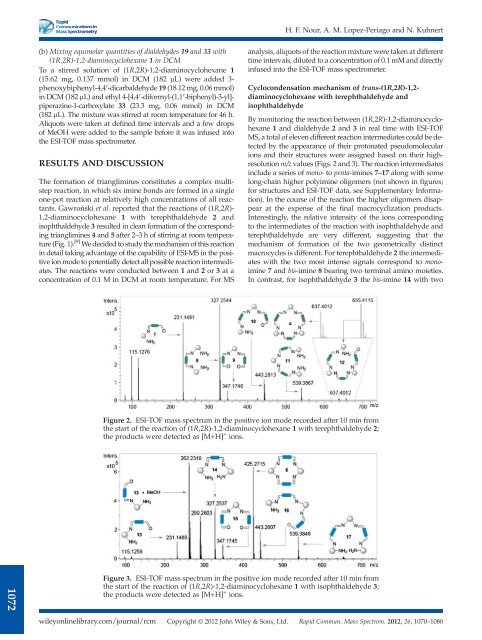The Development of Novel Antibiotics Using ... - Jacobs University
The Development of Novel Antibiotics Using ... - Jacobs University
The Development of Novel Antibiotics Using ... - Jacobs University
You also want an ePaper? Increase the reach of your titles
YUMPU automatically turns print PDFs into web optimized ePapers that Google loves.
H. F. Nour, A. M. Lopez-Periago and N. Kuhnert<br />
(b) Mixing equimolar quantities <strong>of</strong> dialdehydes 19 and 33 with<br />
(1R,2R)-1,2-diaminocyclohexane 1 in DCM<br />
To a stirred solution <strong>of</strong> (1R,2R)-1,2-diaminocyclohexane 1<br />
(15.62 mg, 0.137 mmol) in DCM (182 mL) were added 3-<br />
phenoxybiphenyl-4,4′-dicarbaldehyde 19 (18.12 mg, 0.06 mmol)<br />
in DCM (182 mL) and ethyl 4-[4,4′-diformyl-(1,1′-biphenyl)-3-yl]-<br />
piperazine-1-carboxylate 33 (23.3 mg, 0.06 mmol) in DCM<br />
(182 mL). <strong>The</strong> mixture was stirred at room temperature for 46 h.<br />
Aliquots were taken at defined time intervals and a few drops<br />
<strong>of</strong> MeOH were added to the sample before it was infused into<br />
the ESI-TOF mass spectrometer.<br />
RESULTS AND DISCUSSION<br />
<strong>The</strong> formation <strong>of</strong> trianglimines constitutes a complex multistep<br />
reaction, in which six imine bonds are formed in a single<br />
one-pot reaction at relatively high concentrations <strong>of</strong> all reactants.<br />
Gawroński et al. reported that the reactions <strong>of</strong> (1R,2R)-<br />
1,2-diaminocyclohexane 1 with terephthaldehyde 2 and<br />
isophthaldehyde 3 resulted in clean formation <strong>of</strong> the corresponding<br />
trianglimines 4 and 5 after 2–3 h <strong>of</strong> stirring at room temperature<br />
(Fig. 1). [9] We decided to study the mechanism <strong>of</strong> this reaction<br />
in detail taking advantage <strong>of</strong> the capability <strong>of</strong> ESI-MS in the positive<br />
ion mode to potentially detect all possible reaction intermediates.<br />
<strong>The</strong> reactions were conducted between 1 and 2 or 3 at a<br />
concentration <strong>of</strong> 0.1 M in DCM at room temperature. For MS<br />
analysis, aliquots <strong>of</strong> the reaction mixture were taken at different<br />
time intervals, diluted to a concentration <strong>of</strong> 0.1 mM and directly<br />
infused into the ESI-TOF mass spectrometer.<br />
Cyclocondensation mechanism <strong>of</strong> trans-(1R,2R)-1,2-<br />
diaminocyclohexane with terephthaldehyde and<br />
isophthaldehyde<br />
By monitoring the reaction between (1R,2R)-1,2-diaminocyclohexane<br />
1 and dialdehyde 2 and 3 in real time with ESI-TOF<br />
MS, a total <strong>of</strong> eleven different reaction intermediates could be detected<br />
by the appearance <strong>of</strong> their protonated pseudomolecular<br />
ions and their structures were assigned based on their highresolution<br />
m/z values (Figs. 2 and 3). <strong>The</strong> reaction intermediates<br />
include a series <strong>of</strong> mono- topenta-imines 7–17 along with some<br />
long-chain higher polyimine oligomers (not shown in figures;<br />
for structures and ESI-TOF data, see Supplementary Information).<br />
In the course <strong>of</strong> the reaction the higher oligomers disappear<br />
at the expense <strong>of</strong> the final macrocyclization products.<br />
Interestingly, the relative intensity <strong>of</strong> the ions corresponding<br />
to the intermediates <strong>of</strong> the reaction with isophthaldehyde and<br />
terephthaldehyde are very different, suggesting that the<br />
mechanism <strong>of</strong> formation <strong>of</strong> the two geometrically distinct<br />
macrocycles is different. For terephthaldehyde 2 the intermediates<br />
with the two most intense signals correspond to monoimine<br />
7 and bis-imine 8 bearing two terminal amino moieties.<br />
In contrast, for isophthaldehyde 3 the bis-imine 14 with two<br />
Figure 2. ESI-TOF mass spectrum in the positive ion mode recorded after 10 min from<br />
the start <strong>of</strong> the reaction <strong>of</strong> (1R,2R)-1,2-diaminocyclohexane 1 with terephthaldehyde 2;<br />
the products were detected as [M+H] + ions.<br />
1072<br />
Figure 3. ESI-TOF mass spectrum in the positive ion mode recorded after 10 min from<br />
the start <strong>of</strong> the reaction <strong>of</strong> (1R,2R)-1,2-diaminocyclohexane 1 with isophthaldehyde 3;<br />
the products were detected as [M+H] + ions.<br />
wileyonlinelibrary.com/journal/rcm Copyright © 2012 John Wiley & Sons, Ltd. Rapid Commun. Mass Spectrom. 2012, 26, 1070–1080

















